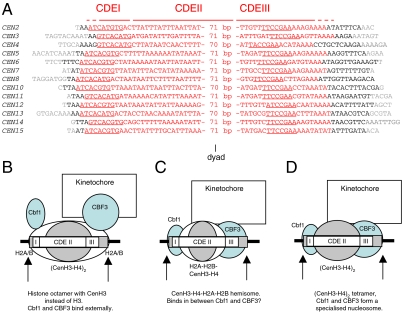Fig. 4.
The position of the CEN nucleosome and implications for models of the CEN nucleosome. A. Alignment of the CEN nucleosome kernels according to their dyad axes (i.e., the centers of the kernel sequences). Nucleotides within the CEN sequence are indicated in red, those outside CEN but within the kernel are in black, and those that are outside the kernel are in gray. Nucleotides underlined in CDEI and CDEIII represent the specific binding sites of Cbf1 and CBF3 (Cep3), respectively. The complete sequences are given in Fig. S2. B–D. Models proposed for centromeric nucleosomes are shown positioned as determined in this work: B. The CenH3 histone octamer model (12) in which CenH3 replaces H3 in an otherwise canonical histone octamer. Because the octamer covers both CDEI and CDEIII, Cbf1 and CBF3 would have to bind to DNA on the outer surface of the CEN nucleosome. C. The hemisome model proposes a tetramer or half-nucleosome composed of CenH3, H4, H2A, and H2B (13). D. A (CenH3-H4)2 tetramer (equivalent to the canonical (H3-H4)2 tetramer) forms an atypical nucleosome with Cbf1 and CBF3 (10). Cbf1 and CBF3 bind specifically to CDEI and CDEIII respectively, and so could fix the positions of the other components. In all of these models, the position of the CEN nucleosome requires that the histone component interacts primarily with CDEII, the extremely AT-rich region between the Cbf1 and CBF3 sites.

